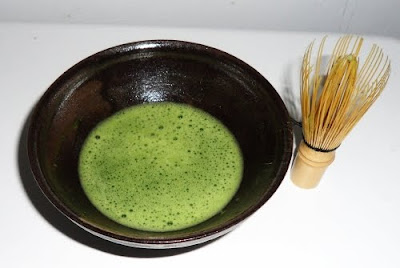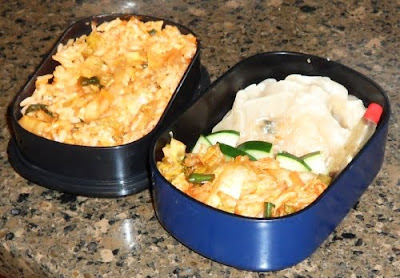 Easy as pie(which isn't actually that easy to make, so... easier than pie?), tasty, and cute.
Easy as pie(which isn't actually that easy to make, so... easier than pie?), tasty, and cute.Saturday, March 26, 2011
Mini Matcha Bunny Cakes
 Easy as pie(which isn't actually that easy to make, so... easier than pie?), tasty, and cute.
Easy as pie(which isn't actually that easy to make, so... easier than pie?), tasty, and cute.Thursday, March 24, 2011
The Green Stuff

Sunday, March 20, 2011
Ready, set... GROW!
 Update from this post. If it were a race, I would not be optimistic for the catnip, though it is so cute and tiny.
Update from this post. If it were a race, I would not be optimistic for the catnip, though it is so cute and tiny.
Friday, March 18, 2011
Large Leaf from Old Trees Pu' erh
 Got this as a sample from Chicago Tea Garden and it's nearly everything I like in a pu'erh.
Got this as a sample from Chicago Tea Garden and it's nearly everything I like in a pu'erh.Thursday, March 17, 2011
Kimchi Jjigae(김치찌개)
 This is, in short, a soup/stew made using kimchi. It's very spicy and very delicious. Also, pretty easy to make.
This is, in short, a soup/stew made using kimchi. It's very spicy and very delicious. Also, pretty easy to make.Sunday, March 13, 2011
New Chawan

Zealong Pure
 ...and bunnies.
...and bunnies. 

However, once over that bump, it was rather delicious. Still buttery, though with a bit of a sweet floral note to it and a lovely scent to match.
Thursday, March 10, 2011
1990s Malaysian-Stored Raw Puerh Brick



Wednesday, March 9, 2011
Box o' Kimchi
 Tonight I've decided it's time to make more kimchi. In that regard, it's also time to get rid of the last of the last batch. So, bento to the rescue!
Tonight I've decided it's time to make more kimchi. In that regard, it's also time to get rid of the last of the last batch. So, bento to the rescue!
Monday, March 7, 2011
Prepara Power Plant Mini - GO!
 Okay, so this is only kinda related to food/tea, but my blog, my rules. Got these for sale from my work for roughly ~$8 a piece(ngl, never would have given them a shot at regular price: ~$30-40). Today I loaded them up for the first time, hope this goes well.
Okay, so this is only kinda related to food/tea, but my blog, my rules. Got these for sale from my work for roughly ~$8 a piece(ngl, never would have given them a shot at regular price: ~$30-40). Today I loaded them up for the first time, hope this goes well. Sunday, March 6, 2011
Jiao zi(餃子)

...or mandu or potstickers or gyoza or momo-cha or dumplings or whatever you want to call them.
Yes, they'll look different depending on how you close the top and the whether your wrappers are circles or squares, but ultimately the process is pretty much the same.
For the filling, finely chop and/or grate whatever veggies interest you. Here I used grated carrot/daikon/potato with finely chopped garlic/mushroom/broccoli. Kinda westerny, I think, for today. Peas, ginger, bok choy, bean sprouts, napa cabbage, scallions, and just about anything else you're willing to chop very small all make great additions to the filling. Again, this is very much a personal-taste thing.

Typically my set-up[first picture up there] includes: A cutting board or other flat/moveable surface to place the ready ones on. A plate over which to fold them(the plate keeping the table clean and providing something to put them on when ready to eat ;p). A cup of water. A stack of pre-made wrappers(can be found in most any Asian food market and even some Western stores. Be sure to skim ingredients in case of eggs! You can also make these yourself, might get into that with a future post). Bowl of filling w/ spoon or chopsticks. Tea(for drinking). Laptop(for watching Korean dramas while making- optional). ;p
Once settled in, it's time to start! (1) Free one wrapper from the rest. While holding it in your hand, use a spoon/chopsticks/your free hand? to place a bit of the filling in the center of the wrapper. Try to clump it together. (2) Dip a finger from your free hand into the water and wet the edges of the wrapper in a circle around the filling. Carefully, so nothing sticks out, fold the wrapper in half around the filling and press the edges together. This part varies a little from type-to-type so feel free to close it however you like so long as it gets closed! (3) Ta-dah! You've completed one. Only ~49 more to go!
After running out of wrappers, filling, or space(whichever comes first), separate those you don't plan to cook now from the rest onto a cookie sheet. Freeze them on the sheet them dump them into a container or zip-lock bag for later use. Then clean up and move to the stove top. This will explain boiling/frying them, though you can also steam them in a steamer if that's more to your liking.
For boiling though, (1), take a medium-sized pot and fill it with water, place it over medium-high heat until boiling. Going 3-4 at a time, boil your dumplings(it might be a good idea to re-wetten and re-pinch the edges before dropping them in unless you like empty boiled wrappers and veggie-filled water. ;p
Using a strainer or large spoon with holes, fish out the jiao zi once the sides start to become a little more transparent. After you've repeated this process with all the dumplings you can either begin to chow down or move onto the next step, (2) frying(some fry without boiling first, though this was just how I was taught and how I do it. I also normally have some of both so this just works for me).
Setting the frying pan/wok on roughly the same heat used for boiling, lightly coat the bottom in vegetable(or canola or garlic- if you know where to buy garlic oil in the States I will love you forever for telling me!) oil and fry 'em up! Be sure to flip them, with chopsticks or a spatula, (3) then serve them with some dipping sauce or as a side for a meal once lightly brown on both sides!
Also, don't worry if you end up with filling leftover, just toss it in the pan with some leftover white rice from another day/meal and it makes for some really tasty fried rice!
Saturday, March 5, 2011
~New Pot~
Of Zebra Sencha and Pittsburgh tea
 For roughly a week at the very tail end of December, I visited some family in Pennsylvania. While I brought tea with me, I was eager to see what Pittsburgh had to offer.
For roughly a week at the very tail end of December, I visited some family in Pennsylvania. While I brought tea with me, I was eager to see what Pittsburgh had to offer. Kimchi Jeon(김치전)
 Apparently I am pretty bad at the 'everyday' thing. But, I do promise to post often enough(so vague, yes?).
Apparently I am pretty bad at the 'everyday' thing. But, I do promise to post often enough(so vague, yes?).

